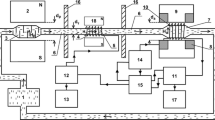Abstract
The need to expand the functionality of systems for monitoring the parameters of the flow of liquid media is substantiated. This article presents the advantages of using meters based on nuclear magnetic resonance (NMR) to control the parameters of the flow of liquid media. This paper also aims to solve the problems that arise during the operation of NMR flowmeters-relaxometers in two measurement modes (i.e., pulse mode and mode with periodic modulation of the magnetic field in the NMR signal recording system). Notably, the main problem in the operation of these devices is associated with an increase in the error in measuring liquid flow or the termination of its measurement process with rapid changes in liquid flow. The use of a magnetic mark mode, which helps solve the aforementioned problem, significantly limits the possibilities of using NMR flowmeters-relaxometers when used to monitor the parameters of liquid media or with a large increase in the flowing medium temperature. A method for creating a magnetic mark at the noise level for measuring liquid flow is proposed. In this method, changing the composition of the flowing medium or replacing the liquid does not have a significant effect on the formation of a magnetic mark at the noise level in a strong inhomogeneous magnetic field (i.e., the noise amplitude is several times higher than the signal amplitude). The results of experimental studies of the nutation line from changes in the magnetic field gradient are presented. A mathematical model based on the modified Bloch equations is developed, and the relationships between the magnetic field parameters are established to implement the magnetic mark mode in the NMR signal with magnetization inversion at the noise level. The proposed method ensures that the influence of rapid changes in the value of liquid flow (by a factor of 10 or more) on the flow measurement error is insignificant.




Similar content being viewed by others
References
Davydov, V., Gureeva, I., Davydov, R., Dudkin, V.: Energies 15(2), 457 (2022). https://doi.org/10.3390/en15020457
Gui, M., Shan, J., Liu, Y., Wu, P., Liang, Y., Zhang, F.: Ann Nucl Energy 194, 110084 (2023). https://doi.org/10.1016/j.anucene.2023.110084
Zhang, Z., Liu, H., Song, T., Zhang, Q., Yang, L.B.K.: Ann Nucl Energy 165, 108766 (2022). https://doi.org/10.1016/j.anucene.2021.108766
Kashaev, R.S., Kien, N.T., Tung, C.V., Kozelkov, O.V.: Pet. Chem. 59, 21–S29 (2019). https://doi.org/10.1134/S0965544119130073
Safiullin, K., Kuzmin, V., Bogaychuk, A., Klochkov, A., Tagirov, M.: J. Pet. Sci. Eng. 210, 110010 (2022). https://doi.org/10.1016/j.petrol.2021.110010
Kashaev, R.S., Kien, N.C., Tung, T.V., Kozelkov, O.V.: J. Appl. Spectrosc. 86(5), 890–895 (2019). https://doi.org/10.1007/s10812-019-00911-4
O’Neill, K.T., Klotz, A., Stanwix, P.L.: Flow Meas. Instrum. 58, 104–111 (2017). https://doi.org/10.1016/j.flowmeasinst.2017.10.004
Davydov, V.V., Myazin, N.S., Davydov, R.V.: Meas. Techn., 65. No 6, 444–452 (2022). https://doi.org/10.1007/s11018-022-02103-7
Gizatullin, B., Gafurov, M., Murzakhanov, F., Mattea, C., Stapf, S.: Langmuir 37(22), 6783–6791 (2021). https://doi.org/10.1021/acs.langmuir.1c00882
Davydov, V.V., Myazin, N.S., Davydov, R.V.: Meas. Techn., 65. No 4, 279–289 (2022). https://doi.org/10.1007/s11018-022-02080-x
Kashaev, R.S., Suntsov, I.A., Tung, C.V., Usachev, A.E., Kozelkov, O.V.: J. Appl. Spectrosc. 86(2), 289–293 (2019). https://doi.org/10.1007/s10812-019-00814-4
Zargar, M., Johns, M.L., Aljindan, J.M., Noui-Mehidi, M.N., O’Neill, K.T.: Spe Prod. Oper. 36(2), 423–436 (2021). https://doi.org/10.2118/205351-PA
Sahu, S., Prajapati, A., Kumar, M., Bhattacharyay, R.: Flow Meas. Instrum. 66, 190–199 (2019). https://doi.org/10.1016/j.flowmeasinst.2019.03.008
Zhernovoi, A.I., Dyachenko, S.V.: Russ. Phys. J. 58(1), 133–137 (2015). https://doi.org/10.1007/s11182-015-0472-2
Davydov, V.V., Dudkin, V.I.: A. Yu. Karseev V. A. Vologdin j. Appl. Spectrosc. 82(6), 1013–1019 (2015). https://doi.org/10.1007/s10812-016-0220-6
Davydov, V.V., Dudkin, V.I.: and A. Yu. Karseev russ Phys. J. 58(2), 146–152 (2015). https://doi.org/10.1007/s11182-015-0475-z
Davydov, V.V., Dudkin, V.I.: and A. Yu. Karseev instrum. Exp. Techn. 58(6), 787–793 (2015). https://doi.org/10.1134/S0020441215060056
Davydov, V.V., Dudkin, V.I., Velichko, E.N.: Meas. Techn., 59. No 2, 176–182 (2016). https://doi.org/10.1007/s11018-016-0938-9
Alekseev, P.N., Gagarinskii, A.Y., Kalugin, M.A., Fomichenko, P.A., Asmolov, V.G.: Atom. Energy 126(4), 207–212 (2019). https://doi.org/10.1007/s10512-019-00538-w
Adamov, E.O., Ivanov, V.K., Mochalov, Y.S., Lachkanov, E.V., Orlov, A.I.: Atom. Energy 132(3), 133–142 (2022). https://doi.org/10.1007/s10512-023-00916-5
Bloch, F.: Phys. Rev. 70(7), 460–474 (1946). https://doi.org/10.1103/PhysRev.70.474
Bloch, F., Wangsness, R.K.: Phys. Rev. 78(1), 82–89 (1950). https://doi.org/10.1103/PhysRev.89.728
Author information
Authors and Affiliations
Corresponding author
Ethics declarations
Conflict of interest
The authors declare no conflict of interest.
Additional information
Translated from Izmeritel’naya Tekhnika, No. 11, pp. 58–65, November, 2023. Russian DOI: https://doi.org/10.32446/0368-1025it.2023-11-58-65
Publisher’s Note
Springer Nature remains neutral with regard to jurisdictional claims in published maps and institutional affiliations.
Original article submitted October 15, 2023. Original article reviewed November 13, 2023. Original article accepted November 13, 2023
Rights and permissions
Springer Nature or its licensor (e.g. a society or other partner) holds exclusive rights to this article under a publishing agreement with the author(s) or other rightsholder(s); author self-archiving of the accepted manuscript version of this article is solely governed by the terms of such publishing agreement and applicable law.
About this article
Cite this article
Davydov, V.V., Gol’dberg, A.A., Dudkin, V.I. et al. Method of liquid consumption measurement in nuclear magnetic resonance flowmeters-relaxometers. Meas Tech (2024). https://doi.org/10.1007/s11018-024-02303-3
Published:
DOI: https://doi.org/10.1007/s11018-024-02303-3




